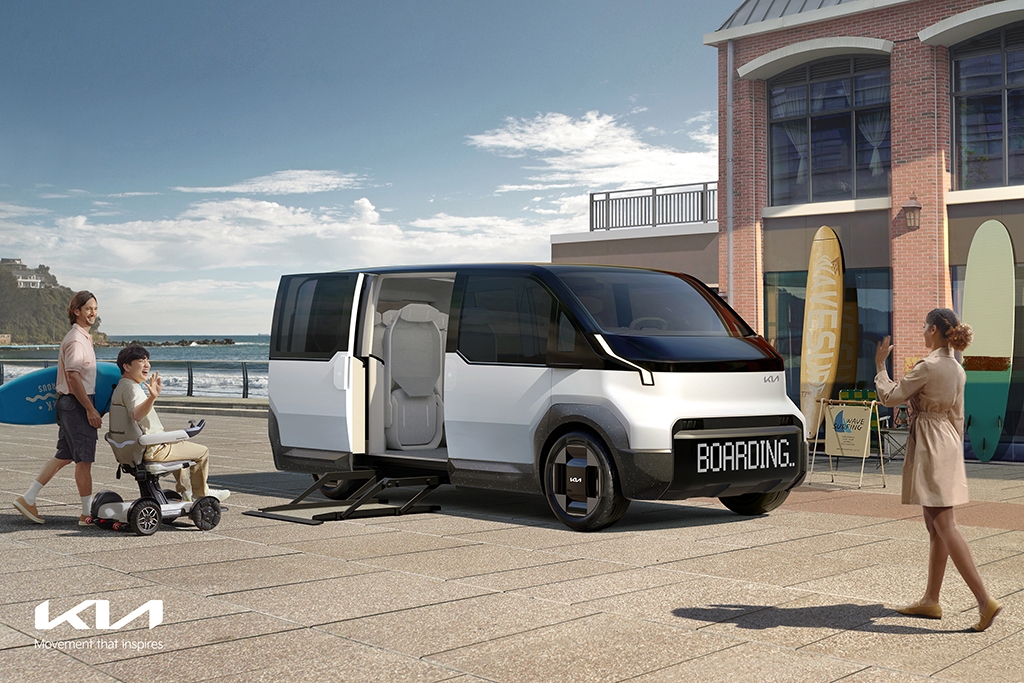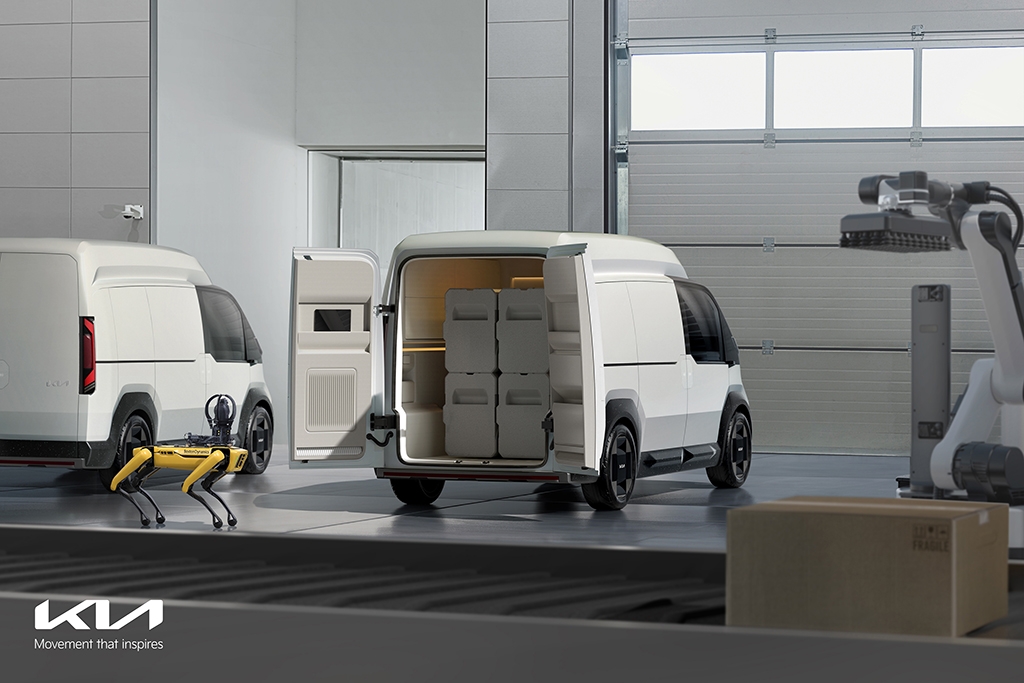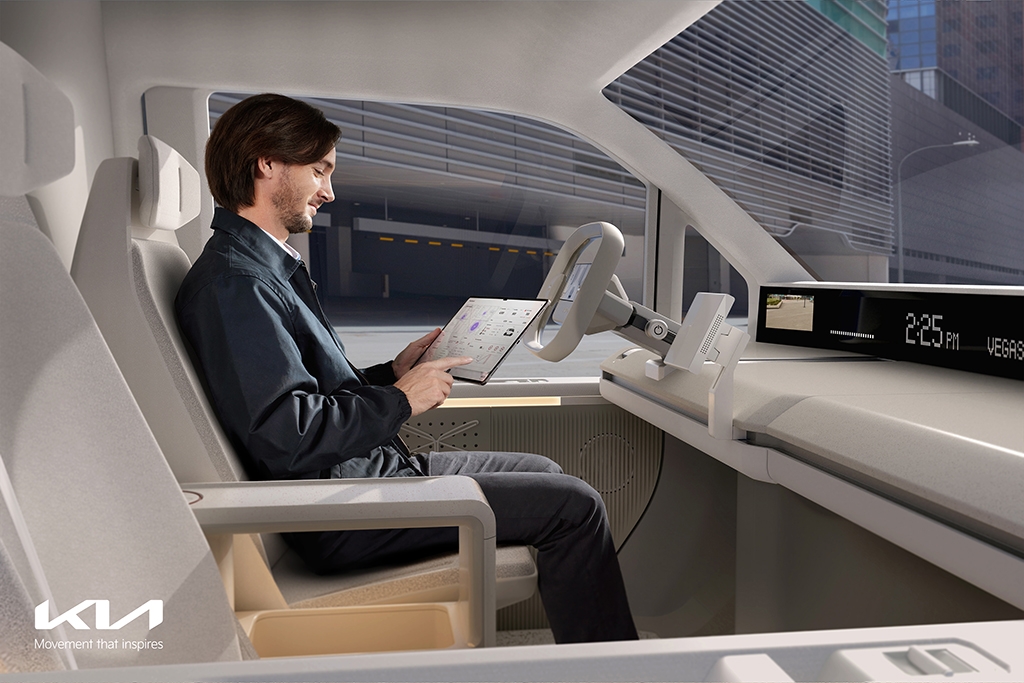Kia reveals new PBV business strategy
09 Jan 2024|265 views
Kia has revealed its Purpose Built Vehicle (PBV) business strategy at the 2024 Consumer Electronics Show in Las Vegas. Called the 'Platform Beyond Vehicle', Kia's business strategy comes as a multi-phase plan that Kia states will see the sector revolutionise the mobility industry and advance Hyundai Motor Group's ambitions in robotics, Advanced Air Mobility, as well as autonomous driving.
In the first phase, Kia will introduce a new PV5 electric vehicle that is optimised for fields including ride-hailing, deliveries, and utilities. This vehicle will be offered in a variety of versions including 'Basic', 'Van', 'High Roof', and 'Chassis Cab'.
The Kia PV5 will come with a variety of interchangeable upper bodies that allows it to convert from a delivery van into a taxi when needed
Built atop what Kia states is a weld-less body structure that will allow a high degree of modularisation, the vehicle will allow a variety of interchangeable upper bodies, or 'life modules' to be connected to its base vehicle via a hybrid electromagnetic and mechanical coupling technology. This will allow the Kia PV5 to operate, for example, as a taxi during the day and turn into a delivery van at night, or to serve as a personal recreational vehicle on the weekend.
The platform is comprised of high-strength tubular steel and engineered polymers, allowing a 55% reduction in total parts without any loss in rigidity. The Kia PV5 will also make extensive use of sustainable materials including bio and recycled plastic as well as bio paint and recycled PET fabric.
Kia also states that this vehicle will offer a pillar-less opening for effortless ingress and egress, while its cockpit can also serve as a desk-like surface, and its steering wheel folded to serve as a desk lamp.
Phase two of Kia's Platform Beyond Vehicle strategy will see the introduction of two more vehicles. The first, PV1, will be the smallest product in the lineup, and is optimised for agile, short-distance transportation. This vehicle is said to make use of driving modules to minimise its turning radius to fit narrow spaces.
The second, called the PV7, will be the largest in the lineup, and is defined by its generous interior space and high range. Both these vehicles will come with an integrated rail system on their ceiling, floor, and side panels, as well as on the exterior, designed to enable effortless customisation to meet individual customer needs.
Kia states that phase three of its PBV business strategy will see its vehicles evolve into highly customisable, bespoke mobility solutions that are connected and operate as part of a smart city operating system.
Production of these PBVs will be done at a PBV-dedicated plant in Autoland Hwaseong, Korea, which will implement a hybrid production approach, combining conveyor and cell-based methods. The factory is set to become operational in 2025 and will have an annual capacity of 150,000 units.
Kia has revealed its Purpose Built Vehicle (PBV) business strategy at the 2024 Consumer Electronics Show in Las Vegas. Called the 'Platform Beyond Vehicle', Kia's business strategy comes as a multi-phase plan that Kia states will see the sector revolutionise the mobility industry and advance Hyundai Motor Group's ambitions in robotics, Advanced Air Mobility, as well as autonomous driving.
In the first phase, Kia will introduce a new PV5 electric vehicle that is optimised for fields including ride-hailing, deliveries, and utilities. This vehicle will be offered in a variety of versions including 'Basic', 'Van', 'High Roof', and 'Chassis Cab'.
The Kia PV5 will come with a variety of interchangeable upper bodies that allows it to convert from a delivery van into a taxi when needed
Built atop what Kia states is a weld-less body structure that will allow a high degree of modularisation, the vehicle will allow a variety of interchangeable upper bodies, or 'life modules' to be connected to its base vehicle via a hybrid electromagnetic and mechanical coupling technology. This will allow the Kia PV5 to operate, for example, as a taxi during the day and turn into a delivery van at night, or to serve as a personal recreational vehicle on the weekend.
The platform is comprised of high-strength tubular steel and engineered polymers, allowing a 55% reduction in total parts without any loss in rigidity. The Kia PV5 will also make extensive use of sustainable materials including bio and recycled plastic as well as bio paint and recycled PET fabric.
Kia also states that this vehicle will offer a pillar-less opening for effortless ingress and egress, while its cockpit can also serve as a desk-like surface, and its steering wheel folded to serve as a desk lamp.
Phase two of Kia's Platform Beyond Vehicle strategy will see the introduction of two more vehicles. The first, PV1, will be the smallest product in the lineup, and is optimised for agile, short-distance transportation. This vehicle is said to make use of driving modules to minimise its turning radius to fit narrow spaces.
The second, called the PV7, will be the largest in the lineup, and is defined by its generous interior space and high range. Both these vehicles will come with an integrated rail system on their ceiling, floor, and side panels, as well as on the exterior, designed to enable effortless customisation to meet individual customer needs.
Kia states that phase three of its PBV business strategy will see its vehicles evolve into highly customisable, bespoke mobility solutions that are connected and operate as part of a smart city operating system.
Production of these PBVs will be done at a PBV-dedicated plant in Autoland Hwaseong, Korea, which will implement a hybrid production approach, combining conveyor and cell-based methods. The factory is set to become operational in 2025 and will have an annual capacity of 150,000 units.
Latest COE Prices
August 2025 | 1st BIDDING
NEXT TENDER: 20 Aug 2025
CAT A$102,009
CAT B$123,498
CAT C$70,001
CAT E$122,334
View Full Results Thank You For Your Subscription.






























